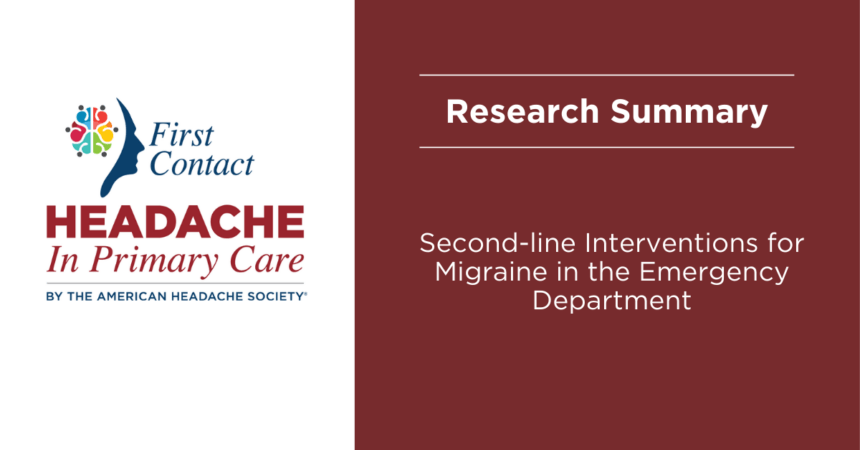
Research Summary: Second-line Interventions for Migraine in the Emergency Department
Summarized by Anna Pace, MD
Headache®: The Journal of Head and Face Pain published “Second-line interventions for migraine in the emergency department: A narrative review.”
Millions of patients visit emergency departments (ED) each year for the treatment of migraine. However, for up to one-third of treated patients, first-line agents like metoclopramide, prochlorperazine and sumatriptan fail to provide sufficient relief. This study’s objective was to discuss the evidence supporting the use of second-line agents for migraine patients in the ED who didn’t improve adequately after treatment with first-line medications.
Study Methods
- The authors identified all medications reviewed in the “AHS Management of Adults With Acute Migraine in the Emergency Department” guideline. Next, they performed a PubMed search to identify studies of participants who were given medication in the ED, failed to improve sufficiently and then were given another active treatment vs. control.
- Studies included first-line therapies as well as second-line therapies.
Study Results
The authors were only able to identify scant data—most published data on migraine refractory to first-line parenteral medication were not controlled, randomized or blinded.
- Acetaminophen: Two studies post-AHS guideline
-
- The studies found that intravenous (IV) acetaminophen was superior to IV metoclopramide at achieving pain relief. IV acetaminophen was also helpful as an adjunct to prochlorperazine + diphenhydramine vs. prochlorperazine + diphenhydramine alone.
- Dexketoprofen: Three studies post-AHS guideline
-
- The studies found that it was helpful in combination with metoclopramide vs. dexketoprofen alone vs. metoclopramide alone, and dexketoprofen was more effective than placebo within an hour of treatment.
- Ketorolac: Two studies post-AHS guideline
-
- The studies found no difference among patients who received dexamethasone 8 mg vs. ketorolac 30 mg vs. metoclopramide 10 mg vs. chlorpromazine 5 mg. There was also no difference between patients who received an intramuscular (IM) injection of ketorolac vs. oral diclofenac.
- Haloperidol: One study post-AHS guideline
-
- Haloperidol 2.5 mg showed a superior reduction in pain severity compared to normal saline at 30 min. and 60 min.
- Valproic acid: Two studies post-AHS guideline
-
- One found 15 mg/kg valproic acid was superior to 6 mg subcutaneous sumatriptan. The second showed no difference in efficacy of valproic acid 400 mg IV vs. dexamethasone 16 mg IV in patients without aura, but in patients with aura, valproic acid was superior to dexamethasone.
- Opioids: One study post-AHS guideline
-
- Hydromorphone was inferior to prochlorperazine in the ED and at 48 hr.
- Propofol: Two studies post-AHS guideline
-
- One studied propofol vs. standard of care, and pain scores were comparable. The other studied propofol vs. placebo, and propofol failed to outperform placebo with regards to headache freedom, use of rescue medication and desire to receive the same medication again.
- Ketamine: One study post-AHS guideline
-
- Ketamine did not outperform prochlorperazine + diphenhydramine. There were also higher rates of vomiting and rescue med. administration in the ketamine group.
- Magnesium: One study post-AHS guideline
-
- There was no difference in pain scores among groups receiving magnesium 2 g vs. prochlorperazine 10 mg vs. metoclopramide 10 mg.
- Dexamethasone: Three studies post-AHS guideline
-
- One study found dexamethasone 8 mg outperformed valproic acid 400 mg on some outcomes. Another study found that the number of patients who received dexamethasone + metoclopramide and required rescue medication in the ED was fewer compared to those in the metoclopramide + methylprednisolone acetate group who required more rescue medication.
- Greater occipital nerve block (GONB): Three studies post-AHS guideline
-
- One study found that those who had persistent pain after receiving metoclopramide and then received a true GONB with bupivacaine had greater rates of headache freedom than those who received a sham control. The second study found those who received a bupivacaine GONB vs. sham had more pain relief than sham. The third study showed that bupivacaine GONB, done by experienced hands, was at least as effective as IV metoclopramide.
- Acetylsalicylic acid, diclofenac, dihydroergotamine and granisetron did not have further studies.
Implications for Primary Care Clinicians
- If a patient fails to improve after one dose of injectable medication, it is reasonable to re-dose the initial medication or try a crossover strategy. If someone does not respond to an antidopaminergic anti-emetic, one can try sumatriptan, and vice versa.
- For patients who fail to improve after administration of first-line medication, it is reasonable to use an IV NSAID or IV acetaminophen.
- There is some data supporting the efficacy of valproic acid.
- Most data published to date demonstrate no role for propofol and ketamine.
- Based on data, it seems greater occipital nerve blocks can also be effective, so this can be offered if the clinician is adept at nerve block administration.
This summary is part of the First Contact—Headache in Primary Care initiative, an American Headache Society program that provides educational resources to empower healthcare professionals and improve headache and migraine care. We encourage providers in all stages of their careers to visit our homepage to access educational tools to improve patient care.


